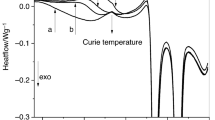Abstract
Mechanical twinning in polycrystalline quartz was investigated in situ with time-of-flight neutron diffraction and a strain diffractometer. Dauphiné twinning is highly temperature sensitive. It initiates at a macroscopic differential stress of 50–100 MPa and, at 500°C, saturates at 400 MPa. From normalized diffraction intensities the patterns of preferred orientation (or texture) can be inferred. They indicate a partial reversal of twinning during unloading. The remaining twins impose residual stresses corresponding to elastic strains of 300–400 microstrain. Progressive twinning on loading and reversal during unloading, as well as the temperature dependence, can be reproduced with finite element model simulations.












Similar content being viewed by others
References
Agnew SR, Duygulu O (2005) Plastic anisotropy and the role of non-basal slip in magnesium alloy AZ31B. Int J Plast 21:1161–1193
Barber DJ, Wenk H-R (1979) Deformation twinning in calcite, dolomite, and other rhombohedral carbonates. Phys Chem Miner 5:141–165
Barton NR, Wenk H-R (2007) Dauphiné twinning in polycrystalline quartz. Modell Simul Mater Sci Eng (in press)
Barton NR, Benson DJ, Becker R (2005) Crystal level continuum modelling of phase transformations: the α↔ɛ transformation in iron. Modell Simul Mater Sci Eng 13:707–731
Brown DW, Bourke MAM, Clausen B, Holden TM, Tome CN, Varma R (2003) A neutron diffraction and modeling study of uniaxial deformation of polycrystalline beryllium. Met Mater Trans A 34A:1439–1449
Daymond MR (2006) Internal stresses in deformed crystal aggregates. In: Wenk HR (ed) Neutron Scattering in Earth Sciences. Rev Miner Geochem 63:427–458
El-Danaf E, Kalindi SR, Doherty RD (1999) Influence of grain size and stacking fault energy on deformation twinning in Fcc metals. Metall Mater Trans A30:1223–1233
Fitzpatrick ME, Lodini A (eds) (2003) Analysis of residual stress by diffraction using neutron and synchrotron radiation. Taylor & Francis, London, p 354
Harrison RJ, Redfern SAT, Buckley A, Salje EKH (2003) Application of real-time, stroboscopic x-ray diffraction with dynamical mechanical analysis to characterize the motion of ferroelastic domains. J Appl Phys 95:1706–1717
Heaney PJ (1994) Structure and chemistry of the low pressure silica polymorphs. In: Heaney PJ, Prewitt CT, Gibbs GV (eds) Silica. Physical behavior, geochemistry and materials applications, Chap 1. Rev Mineral 29:1–32
Johnson MW, Daymond MR (2002) An optimum design for a time-of-flight neutron diffractometer for measuring engineering stresses. J Appl Cryst 35:49–57
Kihara K (1990) An X-ray study of the temperature dependence of the quartz structure. Eur J Mineral 2:63–77
Kimizuka H, Kaburaki H, Kogure Y (2003) Molecular-dynamics study of the high-temperature elasticity of quartz above the α−β phase transition. Phys Rev B 67:024105
Larson AC, Von Dreele RB (2004) General structure analysis system (GSAS). Los Alamos Natl Lab Rep LAUR 86–748
Lutterotti L, Matthies S, Wenk H-R (1999) MAUD: a friendly Java program for materials analysis using diffraction. Int Union Crystallogr Comm Powder Diffraction Newsl 21:14–15
Matthies S, Pehl J, Wenk H-R, Vogel S (2005). Quantitative texture analysis with the HIPPO TOF diffractometer. J Appl Cryst 38:462–475
Ohno I (1995) Temperature variation of elastic properties of α-quartz up to the α−β transition. J Phys Earth 43:157–169
Ohno I, Harada K, Yoshitomi C (2006) Temperature variation of elastic constants of quartz across the α–β transition. Phys Chem Minerals 33:1–9
Pehl J, Wenk H-R (2005) Evidence for regional Dauphiné twinning in quartz from the Santa Rosa mylonite zone in Southern California. A neutron diffraction study. J Struct Geol 27:1741–1749
Santisteban JR, Daymond MR, James JA, Edwards L (2006) ENGIN-X: a third generation neutron strain scanner. J Appl Cryst 39:812–825
Smirnov MB, Mirgorodsky AP (1997) Lattice-dynamical study of the α–β phase transition of quartz: soft-mode behavior and elastic anomalies. Physical Review Letters 78:2413–2416
Sorrell AC, Anderson HU, Ackermann RJ (1974) Thermal expansion and the high-low transformation in quartz. II. Dilatometric studies. J Appl Cryst 7:468–473
Trepmann CA, Spray JG (2005) Planar microstructures and Dauphiné twins in shocked quartz from the Charlevoix impact structure, Canada. Geol Soc Am Spec Pap 384:315–328
Tullis J, Tullis TE (1972) Preferred orientation produced by mechanical Dauphiné twinning. Thermodynamics and axial experiments. Am Geophys Union Monogr 16:67–82
Wenk H-R (2006) Neutron diffraction texture analysis. In Neutron Scattering in Earth Sciences. Reviews in Mineralogy and Geochemistry Volume 63, Mineral Soc Amer, 399–426
Wenk H-R, Lutterotti L, Vogel S (2003) Texture analysis with the new HIPPO TOF diffractometer. Nucl Instrum Methods A 515:575–588
Wenk H-R, Lonardelli I, Vogel SC, Tullis J (2005) Dauphiné twinning as evidence for an impact origin of preferred orientation in quartzite: an example from Vredefort, South Africa. Geology 33:273–276
Wenk H-R, Lonardelli I, Rybacki E, Dresen G, Barton N, Franz H, Gonzalez G (2006) Dauphiné twinning and texture memory in polycrystalline quartz. Part 1: experimental deformation of novaculite. Phys Chem Minerals 33:667–676
Acknowledgments
We are appreciative to Erik Rybacki for providing novaculite samples. In situ deformation measurements were performed with neutron diffraction at LANSCE (SMARTS) and ISIS (ENGIN-X). Comments from C. McCammon, J. Tullis and an anonymous reviewer were very helpful. Research was supported by NSF (EAR 0337006), DOE (DE-FG02-05ER15637) and IGPP-LLNL. The work of NB was performed under the auspices of the U.S. Department of Energy by University of California, Lawrence Livermore National Laboratory under Contract W-7405-Eng-48 (UCRL-JRNL-227703).
Author information
Authors and Affiliations
Corresponding author
Rights and permissions
About this article
Cite this article
Wenk, HR., Bortolotti, M., Barton, N. et al. Dauphiné twinning and texture memory in polycrystalline quartz. Phys Chem Minerals 34, 599–607 (2007). https://doi.org/10.1007/s00269-007-0174-6
Received:
Accepted:
Published:
Issue Date:
DOI: https://doi.org/10.1007/s00269-007-0174-6




